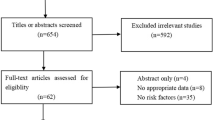Abstract
Postoperative delirium and its risk factors had been widely reported in several kinds of surgeries; however, there is only one known article relative to postoperative delirium in spinal surgery. We retrospectively examined the incidence of postoperative delirium and the probable risk factors in patients undergoing spinal surgery in our hospital, with the same aged non-delirium patients as controls, over a 6-month period. Studies about postoperative delirium were reviewed and referenced for variable factors collecting in our study. T tests, χ 2 test and logistic regression analysis were performed to evaluate the various factors related to postoperative delirium. A total of 18 patients (3.3%), all of them were aged 54 years or older, had postoperative delirium after surgery. Patients without postoperative delirium aged 54 years or older served as the control group. The percentage of patients older than 65 years (P = 0.003), with comorbid diseases such as diabetes mellitus (P = 0.042) or central nervous system disorders (P = 0.013), with a surgical history (P = 0.028) in delirium group was larger than the control group. The absolute number of medications being taken before the operation in the delirium patients was also more than the control group (P = 0.000). The percentage of patients transfused with 800 mL or more blood was also larger (P = 0.024) in delirium group was larger than the control group. Logistic regression analysis showed that central nervous system disorder (OR 6.480), surgical history (OR 3.499), age older than 65 years (OR 3.390), diabetes mellitus (OR 2.981), transfused 800 mL or more blood (OR 2.537), and hemoglobin less than 100 g/L (OR 0.281) were significantly related to the occurrence postoperative delirium. Our findings suggest that postoperative delirium in spinal surgery can also occurred in younger patients and with an acceptable incidence in total. The risk for postoperative delirium is multifactorial. More prospective research is necessary in order to evaluate these and other risk factors in greater detail.
Similar content being viewed by others
References
Adunsky A, Levy R, Heim M et al (2002) Meperidine analgesia and delirium in aged hip fracture patients. Arch Gerontol Geriatr 35:253–259. doi:10.1016/S0167-4943(02)00045-6
Amador LF, Goodwin JS (2005) Postoperative delirium in the older patient. J Am Coll Surg 200:767–773. doi:10.1016/j.jamcollsurg.2004.08.031
American Psychiatric Association (1994) Diagnostic and statistical manual of mental disorders, 4th edn. American Psychiatric Association, Washington DC
Brown TM, Boyle MF (2002) Delirium. BMJ 325:644–647. doi:10.1136/bmj.325.7365.644
Bucerius J, Gummert JF, Borger MA et al (2004) Predictors of delirium after cardiac surgery delirium: effects of beating-heart (off-pump) surgery. J Thorac Cardiovasc Surg 127:57–64. doi:10.1016/S0022-5223(03)01281-9
Culley DJ, Baxter M, Yukhananov R et al (2003) The memory effects of general anesthesia persist for weeks in young and aged rats. Anesth Analg 96:1004–1009. doi:10.1213/01.ANE.0000052712.67573.12
Ergina PL, Gold SL, Meakins JL (1993) Perioperative care of the elderly patient. World J Surg 17:192–198. doi:10.1007/BF01658926
Franks NP, Lieb WR (1994) Molecular and cellular mechanisms of general anaesthesia. Nature 367:607–614. doi:10.1038/367607a0
Inouye SK (2006) Delirium in older persons. N Engl J Med 354:1157–1165. doi:10.1056/NEJMra052321
Inouye SK, Charpentier PA (1996) Precipitating factors for delirium in hospitalized elderly persons: predictive model and interrelationship with baseline vulnerability. JAMA 275:852–857. doi:10.1001/jama.275.11.852
Inouye SK, Viscoli CM, Horwitz RI et al (1993) A predictive model for delirium in hospitalized elderly medical patients based on admission characteristics. Ann Intern Med 119:474–481
Kawaguchi Y, Kanamori M, Ishihara H et al (2006) Postoperative delirium in spine surgery. Spine J 6:164–169. doi:10.1016/j.spinee.2005.06.010
Kazmierski J, Kowman M, Banach M et al (2006) Preoperative predictors of delirium after cardiac surgery: a preliminary study. Gen Hosp Psychiatry 28:536–538. doi:10.1016/j.genhosppsych.2006.08.007
Koolhoven I, Tjon-A-Tsien MR, van der Mast RC (1996) Early diagnosis of delirium after cardiac surgery. Gen Hosp Psychiatry 18:448–451. doi:10.1016/S0163-8343(96)00089-8
Lynch EP, Lazor MA, Gellis JE et al (1998) The impact of postoperative pain on the development of postoperative delirium. Anesth Analg 86:781–785. doi:10.1097/00000539-199804000-00019
Magnusson KR, Scanga C, Wagner AE et al (2000) Changes in anesthetic sensitivity and glutamate receptors in the aging canine brain. J Gerontol A Biol Sci Med Sci 55:B448–B454
Marcantonio ER, Goldman L, Orav EJ et al (1998) The association of intraoperative factors with the development of postoperative delirium. Am J Med 105:380–384. doi:10.1016/S0002-9343(98)00292-7
O’Brien D (2002) Acute postoperative delirium: definitions, incidence, recognition, and interventions. J Perianesth Nurs 17:384–392. doi:10.1053/jpan.2002.36783
Schneider F, Bohner H, Habel U et al (2002) Risk factors for postoperative delirium in vascular surgery. Gen Hosp Psychiatry 249:28–34. doi:10.1016/S0163-8343(01)00168-2
Schuurmans MJ, Duursma SA, Shortridge-Baggett LM (2001) Early recognition of delirium: review of the literature. J Clin Nurs 10:721–729. doi:10.1046/j.1365-2702.2001.00548.x
Schuurmans MJ, Duursma SA, Shortridge-Baggett LM et al (2003) Elderly patients with a hip fracture: the risk for delirium. Appl Nurs Res 16:75–84. doi:10.1016/S0897-1897(03)00012-0
William-Russo P, Urquhart BL, Sharrock NE et al (1992) Postoperative delirium: predictors and prognosis in elderly orthopedic patients. J Am Geriatr Soc 40:759–767
Yamagata K, Onizawa K, Yusa H et al (2005) Risk factors for postoperative delirium in patients undergoing head and neck cancer surgery. Int J Oral Maxillofac Surg 34:33–36. doi:10.1016/j.ijom.2004.03.005
Zakriya KJ, Christmas C, Wenz JF Sr et al (2002) Preoperative factors associated with postoperative change in confusion assessment method score in hip fracture patients. Anesth Analg 94:1628–1632. doi:10.1097/00000539-200206000-00050
Author information
Authors and Affiliations
Corresponding author
Rights and permissions
About this article
Cite this article
Gao, R., Yang, Zz., Li, M. et al. Probable risk factors for postoperative delirium in patients undergoing spinal surgery. Eur Spine J 17, 1531–1537 (2008). https://doi.org/10.1007/s00586-008-0771-1
Received:
Revised:
Accepted:
Published:
Issue Date:
DOI: https://doi.org/10.1007/s00586-008-0771-1




